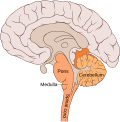Corticobulbar tract
Corticobulbar tract[edit]
The corticobulbar tract is a major pathway in the central nervous system that connects the cerebral cortex to the brainstem. It is responsible for transmitting motor signals from the cortex to the cranial nerves, which control the muscles of the face, head, and neck. This tract plays a crucial role in various voluntary movements, including facial expressions, swallowing, and speech production.
Anatomy[edit]
The corticobulbar tract originates from the primary motor cortex, located in the precentral gyrus of the frontal lobe. It consists of a bundle of nerve fibers that descend through the internal capsule, a white matter structure in the brain. As the fibers pass through the brainstem, they synapse with the motor nuclei of the cranial nerves, forming connections that allow for precise control of facial movements.
Function[edit]
The main function of the corticobulbar tract is to transmit motor commands from the cortex to the cranial nerves. These commands initiate and regulate voluntary movements of the muscles in the face, head, and neck. For example, when we smile, the corticobulbar tract sends signals to the facial muscles, causing them to contract and produce the expression.
In addition to facial expressions, the corticobulbar tract is involved in other important functions. It plays a crucial role in swallowing, as it controls the muscles involved in the process. It also contributes to speech production by coordinating the movements of the muscles responsible for articulation and phonation.
Clinical significance[edit]
Damage or dysfunction of the corticobulbar tract can lead to various motor deficits. For instance, a stroke affecting this pathway may result in facial weakness or paralysis on one side of the face, known as facial palsy. This can affect the ability to make facial expressions, close the eyes, or control saliva production.
Other conditions that can affect the corticobulbar tract include motor neuron diseases, such as amyotrophic lateral sclerosis (ALS), and certain genetic disorders. These conditions can cause progressive muscle weakness and difficulty in performing voluntary movements involving the face, head, and neck.
Conclusion[edit]
The corticobulbar tract is a vital pathway that connects the cerebral cortex to the brainstem, allowing for precise control of facial, head, and neck movements. It plays a crucial role in various voluntary actions, including facial expressions, swallowing, and speech production. Understanding the anatomy and function of this tract is essential for diagnosing and treating motor deficits associated with its damage or dysfunction.

This article is a neuroanatomy stub. You can help WikiMD by expanding it!
-
Diagram of the corticobulbar tract
-
Illustration of the brain bulbar region
-
Structure of hyaluronan
Ad. Transform your life with W8MD's Budget GLP-1 injections from $75


W8MD offers a medical weight loss program to lose weight in Philadelphia. Our physician-supervised medical weight loss provides:
- Weight loss injections in NYC (generic and brand names):
- Zepbound / Mounjaro, Wegovy / Ozempic, Saxenda
- Most insurances accepted or discounted self-pay rates. We will obtain insurance prior authorizations if needed.
- Generic GLP1 weight loss injections from $75 for the starting dose.
- Also offer prescription weight loss medications including Phentermine, Qsymia, Diethylpropion, Contrave etc.
NYC weight loss doctor appointmentsNYC weight loss doctor appointments
Start your NYC weight loss journey today at our NYC medical weight loss and Philadelphia medical weight loss clinics.
- Call 718-946-5500 to lose weight in NYC or for medical weight loss in Philadelphia 215-676-2334.
- Tags:NYC medical weight loss, Philadelphia lose weight Zepbound NYC, Budget GLP1 weight loss injections, Wegovy Philadelphia, Wegovy NYC, Philadelphia medical weight loss, Brookly weight loss and Wegovy NYC
|
WikiMD's Wellness Encyclopedia |
| Let Food Be Thy Medicine Medicine Thy Food - Hippocrates |
Medical Disclaimer: WikiMD is not a substitute for professional medical advice. The information on WikiMD is provided as an information resource only, may be incorrect, outdated or misleading, and is not to be used or relied on for any diagnostic or treatment purposes. Please consult your health care provider before making any healthcare decisions or for guidance about a specific medical condition. WikiMD expressly disclaims responsibility, and shall have no liability, for any damages, loss, injury, or liability whatsoever suffered as a result of your reliance on the information contained in this site. By visiting this site you agree to the foregoing terms and conditions, which may from time to time be changed or supplemented by WikiMD. If you do not agree to the foregoing terms and conditions, you should not enter or use this site. See full disclaimer.
Credits:Most images are courtesy of Wikimedia commons, and templates, categories Wikipedia, licensed under CC BY SA or similar.
Translate this page: - East Asian
中文,
日本,
한국어,
South Asian
हिन्दी,
தமிழ்,
తెలుగు,
Urdu,
ಕನ್ನಡ,
Southeast Asian
Indonesian,
Vietnamese,
Thai,
မြန်မာဘာသာ,
বাংলা
European
español,
Deutsch,
français,
Greek,
português do Brasil,
polski,
română,
русский,
Nederlands,
norsk,
svenska,
suomi,
Italian
Middle Eastern & African
عربى,
Turkish,
Persian,
Hebrew,
Afrikaans,
isiZulu,
Kiswahili,
Other
Bulgarian,
Hungarian,
Czech,
Swedish,
മലയാളം,
मराठी,
ਪੰਜਾਬੀ,
ગુજરાતી,
Portuguese,
Ukrainian


